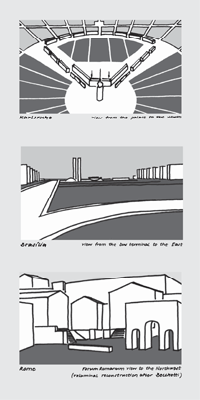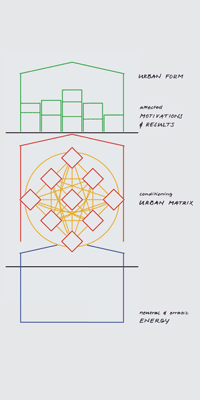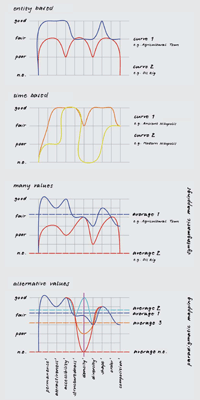
The Parameter Composition'
with its criteria Fabricality at the example Karlsruhe, Figurality at the example of the Eixo Monumental in Brasília and Spatiality at the example of the Forum Romanum.
Composition' as one of three creative parameters consequently determine the spatial design of cities, which can be referring to the urban fabric, to architectonic objects or figures, or to the spatial interplay of various architectures in an urban space.
[plate 78]

The urban matrix
as a dissipative system conditions the neutral and erratic energy that determines the origination and the development of cities and firstly affects urbanistic motivations and ultimately factual urban form itself.
It is thus a explication model for the variety of urban entities, which are despite their functional and formal variety perceived as city.
[plate 81]

Relational mappings
allow for an analysis of the interrelating parameters and thus can lead to comparisons among different settlements as well as different time stages of one settlement.
Syntagmatic mappings in many value contexts furthermore allow for the relative evaluation of two curves, paradigmatic mappings however the effect of changing values within one curve.
[plate 85]
The present employment seeks to approximate the city as a specific anthropogenic transformation of the biosphere as well as a distinct reflexive human design approach towards the environment – ultimately as "culture and geography's largest artifact, the product of a very complex play of greatly varied forces" (Vance Jr 1990: 4). In short, this statement not only points out the object of research to be covered but also enfolds its quandary: What makes us characterize so diverse entities, such as Rothenburg, Ur and Mexico City, which originated in topographically completely unlike settings at a time difference of well more than 3000 years, with the same term – city (Jansen)? And what allows us to draw one transition line from our contemporary urban forms back to the Bronze Age, in which – to common knowledge – the city has its origins?
Exactly for its variety and constant transformation the 'artifact' city is hard to grasp, why most researchers abide by functional aspects for a general understanding and focus formal aspects only in a historical perspective. Still, in addition to the variety of functional assessments there also persists the notion of a formal urban continuum, which appears to be only partly explained by the diverse functional definitions. This present thesis thus shall add to the according manifold functional examinations and ratiocinations, an approach to the city by means of considering the significance of its continuing form and investigating the general factors that determine this form. To this end factors and systemic relations will be elaborated that generally determine urban form, beyond their factual existence and diversity in time and space, an thereby allow for a consistent formal term.
The starting point for this contribution to basic urbanistic research constitute two considerations, which both however do not belong to this discipline:
The first comprises a phenomenological reasoning, that suggests a differentiation and yet intrinsic relation between factual cities and a theoretical concept that serves as an ideal perception of how a city should be. This ratiocination, which was well established by the art historian Giulio Argan in his "Storia dell'arte come storia della città", forms the basis for the suggested perception of an abstractum urban form that consequently allows for an examination of its constitution and characteristics.
The second involves a systemic understanding, that implies a distinct interrelation of various factors that yet erratically afford cities. This ratiocination goes back to the sociologist Niklas Luhmann, and allows explaining the variety as well as the unpredictability of factual urban forms in course of the diversity of opinions and interests involved, while he concurrently insinuates the investigation for conditioning and contingency formulas that determine the process of interrelation.
These considerations together constitute as a thought model the Urban Matrix,
a dissipative, that is an open dynamic system, in which time and space independent parameters by interrelation cause the origination and development of time and space dependent urban forms. Thence the system itself remains abstract, yet determines the concrete motivations of those participating in the design process and ultimately the very factual formal result 'city'. These thoughts imply that the suggested approach is primarily a theoretical-normative occupation, dealing with abstract concepts rather than the actually built environment. Thus, the reader will be confronted with a search for preferably simple and yet copious wordings that shall explain the features of the different conditioning parameters as well as their interrelation within the Urban Matrix.
Still, for the purpose of unambiguousness, this endeavor effects a demonstration of complex circumstances, from which sometimes suffers a convenient readability, as well as familiar expressions have to be put in another context and, where necessary and appropriate, neologisms have to be introduced. Likewise, the argumentation at times has to revert to other disciplines that obviously feature their own language use, which might at first appear to be alien to an urbanistic approach. Of special interest are here the Formal Concept Analysis by Bernhard Ganter und Rudolf Wille, as well as the consierations on Semantics by Gottlob Frege.
The key hypothesis for the suggested approach is the differentiation between Quality and Quantity, which in formal concept analysis is expressed by the correlation of Attributes and Objects, and in semantics by the dichotomy of Intension and Extension. In this context urbanistic quantities are bound in time and space, whereas urbanistic qualities allow for an induction of general aspects. These are examined against the background of an idealized urban foundation and eventually summarized to parameters of urban form. Thus, usually only a safe and healthy place is attractive for the establishment of a city; thence safety and health become criteria for the whole urban development, and ultimately refer to a parameter attractiveness'.
The key conclusion of the thesis however points to the existence of a conditioning system, which factors can be scientifically determined, when yet it offers no injective, surjective, or bijective relations (Eineindeutigkeit), nor any other mathematical formula that insinuates a calculatory approach towards urban form. With this system a retrospective explanation is possible, a prospective predictability still impossible, comparable with Heinz von Foerster's 'Non trivial machine' (Foerster 1985: 62 ff.). Accordingly, the attractiveness of a city can be explained by its safe and healthy location, but not all attractive cities need to locate at especially healthy and safe places, nor give such places a warranty for future attractiveness and prosperous development.
Altogether the thesis consists of four main parts:
1. An introductory Western Reflection of Western Urbanism since the industrialization, which with the development of urbanism as an academic discipline forms the starting point and the scope of an urbanistic basic research – whereas for the lack of a concise field of research this reflection does not represent a classical introduction, but a summarizing intellectual and receptional history followed by the suggestion of another approach and its hermeneutic predicament;
2. The explication of a thought model, which conceptually describes the Causes of Urban Development with its phenomenological and systemic principles and consequently a derivation of abstract factors, whereas this procedure builds the basis for the induction of qualitative parameters of urban form;
3. A Commonsensical Catalogue, which defines the qualitative parameters and their criteria – as well as considerations regarding the establishment of secondary factors within this parametral frameworks; and
4. An Outlook onto the Urban Matrix as an integrating system, which conditions the origination and the development of urban form – whereas firstly the parameters are calibrated with those concepts introduced earlier, secondly the interrelation amongst the different parameters are discussed, and ultimately some rough ideas on possible practical applications are presented.
As stated in the subtitle of this elaboration, the suggested thought model does not represent a concluded theory despite its aimed conceptual conclusiveness; on the contrary shall the discussed phenomenological and systemic considerations initiate further theoretical employments in an urbanistic basic research – last not east, to eventually produce a common perception of the city as very own field of research and work, despite the ongoing acceleration of urbanistic processes that aggravates this task (Seifert 2003: 11). Many of those topics discussed in this thesis derive from the author's experiences during his employment at the Department History of Urbanization (RWTH Aachen University); and many impulses stem from discussions with Michael Jansen, which altogether dealt with the in its substance irresolvable question 'What is a city?' Argan, Giulio C.: Storia dell'arte come storia della città, Riuniti, Roma, 1983
(1989, Kunstgeschichte als Stadtgeschichte, Fink, München).
Foerster, Heinz v.: Entdecken oder Erfinden. Wie läßt sich das Verstehen verstehen? In: Gumin, Heinz & Heinrich Meier (eds.): Einführung in den Konstruktivismus, pg. 41-88, Oldenbourg, München, 1985 (1992, Piper, München).
Frege, Gottlob: Über Sinn und Bedeutung. In: Zeitschrift für Philosophie und philosophische Kritik, vol 100, pg. 25-50, 1892 (Patzig, Günther: Gottlob Frege. Funktion, Begriff, Bedeutung, Fünf logische Studien, pg. 40-65, Vandenhoeck & Ruprecht, Göttingen, 1962/75; Frege, Gottlob: Sense and Reference. In: The Philosophical Review, vol. 57, pg. 207-230, 1948).
Ganter, Bernhard & Rudolf Wille: Formale Begriffsanalyse. Mathematische Grundlagen, Springer, Berlin (1999, Formal Concept Analysis. Mathematical Foundations, Springer, Berlin / New York)
Luhmann, Niklas: Einführung in die Systemtheorie, Carl-Auer, Heidelberg, 1992.
Seifert, Jörg: Urban Research: Biopsy and Density, VDG, Weimar, 2003.
Vance Jr, James E.: The Continuing City. Urban Morphology in Western Civilization, John Hopkins, Baltimore, 1990.
Ley, Karsten: The Urban Matrix. Towards a Theory on the Parameters of Urban Form and their Interrelation. FdR, Aachen, 2009
ISBN 978-3-936971-20-0 / 978-3-936971-25-5; ISSN 1436-7904